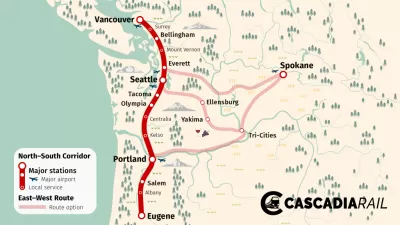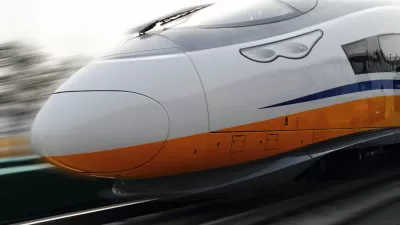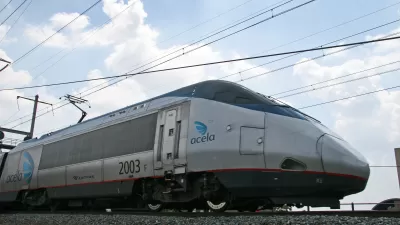A regional high-speed rail network could be coming to the Pacific Northwest, linking cities from Oregon to British Columbia.

A report from the Washington State Department of Transportation(WSDOT) encourages the development of high-speed rail in the region and suggests a framework for bringing ultra-high-speed ground transportation (UHSGT) to the Pacific Northwest.
Leaders from Oregon and British Columbia praised the report as a positive step toward regional collaboration, citing the potential for job growth and economic development. Although "a plan to design a plan" doesn't exactly inspire confidence, writes Doug Trumm, designing a regional system will require close cooperation across state and national lines and coordination with other transit agencies to ensure useful connections to existing and future transit options. The WSDOT report outlines steps in three broad areas: governance, strategic engagement, and funding and finance, with actionable steps to bring the project closer to reality.
In the short term, the plan requires an enabling agreement and the creation of a funded coordinating entity to move the project forward. Stakeholder engagement with indigenous communities and tribal leaders will be particularly important in a region with a long history of colonization and displacement by transportation networks—most notably the transcontinental railroad. The three participating jurisdictions and HSR supporter Microsoft (which sees benefit from improving transportation in its home state) have pledged to support the project. Once planning efforts are underway, the new agency will be responsible for a funding plan to cover the estimated $24 to $42 billion cost of a Portland-to-Vancouver rail system.
FULL STORY: Report Lays Out Framework for a Cascadia High-Speed Rail Authority

Planetizen Federal Action Tracker
A weekly monitor of how Trump’s orders and actions are impacting planners and planning in America.

Maui's Vacation Rental Debate Turns Ugly
Verbal attacks, misinformation campaigns and fistfights plague a high-stakes debate to convert thousands of vacation rentals into long-term housing.

Restaurant Patios Were a Pandemic Win — Why Were They so Hard to Keep?
Social distancing requirements and changes in travel patterns prompted cities to pilot new uses for street and sidewalk space. Then it got complicated.

In California Battle of Housing vs. Environment, Housing Just Won
A new state law significantly limits the power of CEQA, an environmental review law that served as a powerful tool for blocking new development.

Boulder Eliminates Parking Minimums Citywide
Officials estimate the cost of building a single underground parking space at up to $100,000.

Orange County, Florida Adopts Largest US “Sprawl Repair” Code
The ‘Orange Code’ seeks to rectify decades of sprawl-inducing, car-oriented development.
Urban Design for Planners 1: Software Tools
This six-course series explores essential urban design concepts using open source software and equips planners with the tools they need to participate fully in the urban design process.
Planning for Universal Design
Learn the tools for implementing Universal Design in planning regulations.
Heyer Gruel & Associates PA
JM Goldson LLC
Custer County Colorado
City of Camden Redevelopment Agency
City of Astoria
Transportation Research & Education Center (TREC) at Portland State University
Jefferson Parish Government
Camden Redevelopment Agency
City of Claremont





























